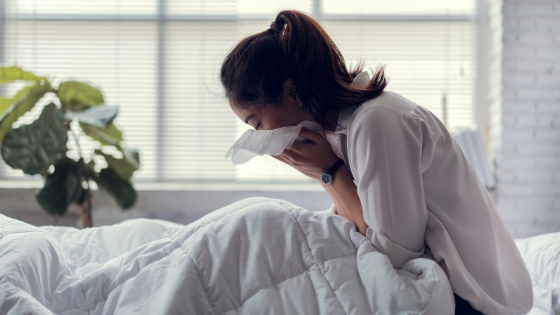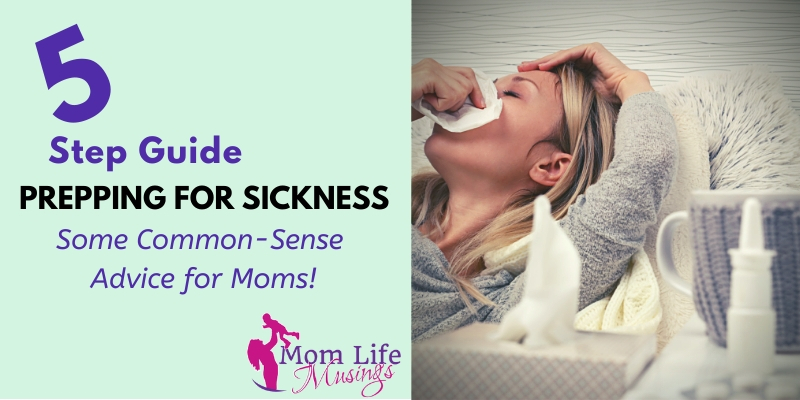This post contains affiliate links. Please see my privacy policy for more information. In addition, the medical information quoted in this post comes directly from the Centers for Disease Control. For more measured, reasonable, and up-to-date regarding best practices for the COVID-19 virus prevention, treatment, and containment, please visit the CDC website HERE. ~ Reminder, I am not a doctor. Please contact 911 in the event of a medical emergency.
In a little over two months, an unknown virus became a daily conversation item in my home and my community. With so much information coming at me from different directions, I found it necessary to sift through some of the sensationalism and come up with some common-sense steps for how my household would respond to the Coronavirus, now officially named, COVID-19.
Right after Valentine’s Day, my home was infected with Influenza A. It. Was. Terrible. My husband and I have both expressed that we’ve NEVER been so sick in our lives. What’s more, there has never been a time when our entire house was sick at the same time. It was a gross and an emotionally draining week. As a mom, I want to give extra tender care to my kiddos (and my hubby) when they are feeling sick. However, I was physical incapable of doing that while we were all sick. I did the best I could, but I wished I had been more prepared for a week at home sick with the flu.
Due to this, my husband and I have already been chatting about the COVID-19 virus for a few extra weeks. We could empathize with what the people in China and abroad were going through.

In response to our conversations, we started to look to reputable sources for a plan of action should the virus make its way to our town. Below is a quick guide to what we’ve learned.
1. Get YOUR House Ready
First and foremost, according to the CDC’s current recommendations, here’s how household’s should be preparing for a local outbreak.
– Practice everyday preventive actions now. Remind everyone in your household of the importance of practicing everyday preventive actions that can help prevent the spread of respiratory illnesses:
– Avoid close contact with people who are sick.
– Stay home when you are sick, except to get medical care.
– Cover your coughs and sneezes with a tissue. (NOTE from post author: Gosh, I didn’t realize this has changed. I’ve been coughing into my sleeve up until I read this. However, with this method, we’re containing the germs AND then disposing of them. It should be noted that you are supposed to always wash your hands after you throw the tissue away.)
– Clean frequently touched surfaces and objects daily (e.g., tables, countertops, light switches, doorknobs, and cabinet handles) using a regular household detergent and water.
– Wash your hands often with soap and water for at least 20 seconds, especially after going to the bathroom; before eating; and after blowing your nose, coughing, or sneezing. If soap and water are not readily available, use a hand sanitizer that contains at least 60% alcohol. Always wash your hands with soap and water if your hands are visibly dirty.
The quote above was taken directly from the CDC’s web page devoted to Get Your Household Ready for Coronavirus Disease 2019 (COVID-19): https://www.cdc.gov/coronavirus/2019-ncov/community/home/get-your-household-ready-for-COVID-19.html
[amazon_auto_links id=”571″]
2. Must-Have Items for Prevention
I have created a couple of shopping lists based on my own experience with the flu a few weeks ago. If you see something you need, save it in your cart or screenshot this, so you don’t forget about it when you do your shopping…

- An adequate supply of hand soap.
- Hand sanitizer that you and your family members can have on hand at all times.
- Boxes and mobile packs of tissues.
- Disinfectant Spray, like Lysol
- Laundry Disinfectant or Clorox Bleach (Did you know that your normal laundry detergent doesn’t actually disinfect your clothes? I didn’t. Thank Goodness that I figured this out!)
3. Keep These Items On-Hand in Case of a Local Outbreak
- Ibuprofen and Acetaminophen
- Cough Suppressants and/or Theraflu® / DayQuil™ and NyQuil™ to help manage symptoms
- Cough Drops or Homeopathic Cough Pops for Kids
- Teas, Herbal (like Peppermint) and Regular
- Pedialyte® (for young children) and
- Gatorade® (for older children/adults)
(((HYDRATE! HYDRATE! HYDRATE!))) - Bone Broth (This made me feel SO MUCH BETTER, when I had the flu!)
- Canned soups, Jell-O® , Ice-pops, and easy meals. (When you are sick, you are NOT going to feel like cooking. Make sure you have some supplies ready. I’ve already heard that Insta-cart is experiencing backups and delays. Don’t rely on them; just have some supplies ready in case.
- Some dry items for when your appetite returns. Crackers and bland cookies are good options to have in your cabinets. Plus, these tend to have a long shelf life. You’ll appreciate having some snacks handy, when you need them.
4. Other Thoughts That May Be Helpful

So, what happens when people around you start to get sick? As moms, we all know that every time we bring our little ones to the doctors, we potentially expose them to other disease. Think about that before you rush your coughing kiddos to the doctor right now. If you are capable of treating yourself and your family at home, then you minimize the risk of transmission to the rest of your community.
With that said, do you have the supplies and the room you will need in order to keep yourself or a member of your family quarantined from the rest of your lot? If not, now is the time to think about where you can safely keep someone in your home.
Obviously, if multiple members of your family get sick, keeping them quarantined to one room will become increasingly difficult. You may need to resolve to allowing the sickness to overtake your home. However, in this case, you will need to be more cautious with outsiders. When my husband and I had the flu, I put a note on the door and asked visitors to drop packages off in a basket outside. If you think people will try to visit you too, you might want to come up with a similar plan.
One last thing to consider is this. While most of us will probably get the COVID-19 virus, and we’ll recover just fine. However, we must be careful to keep our aging populations and those (any age) who have compromised immune systems safe. Do everyone a favor and please stay home if you or a loved one is experiencing symptoms. We must remember that while this virus is going to slow many of us down for our loved ones with lung and heart diseases, cancers, and auto-immune challenges it might be devastating😢. So, let’s work together to keep our family and friends safe.

Of course, our hope is that no one will have to use any of this information. However, in the case that you do, it’s better to be over prepared, than under prepared. (Once a Girl Scout, always a Girl Scout.)
5. Stay Informed
Trust me, I understand that you are being inundated with information right now. I am too. Your friends are talking, your social media feeds are blowing up, the talking heads on the news keep chatting, and now you’re receiving text messages (and even PHONE CALLS!) about the coronavirus. Heck, even I’m sending you messages!?! It’s extremely difficult when it seems the whole world is telling you to be concerned. I get it. BUT, you are a mom; you’ve dealt with chaos before and you are going to be able to help lead your family through this too.
[amazon_auto_links id=”577″]
When things start to get a little overwhelming, take a deep breath and take stock of YOUR current situation. (((The reason I wrote this article is that it is so easy to get carried away with the panic mentality and I don’t want that for any of you.))) So, as I was saying, when things get overwhelming take a deep breath and take stock of your current situation. Grrl, keep YOUR household going. Utilize all of those skills you’ve been developing over the years to protect your little ones. Take temperatures, ease fears, make soups, and give hugs. If it looks like your family’s got a bad flu, stay home and treat them. If anyone has a super-high fever and/or has trouble breathing, call a doctor or an emergency health line immediately for assistance. (Remember, I am not a doctor; I’m just here to give friendly advice. Any time your MOM-dar goes off, it may be time to get some professional health support.)
I recently shared this article on my social media pages, and you might find it helpful to measure exaclty when to “call the doctor.” You might want to check it out here -> Dr. Claire McCarthy, Coronavirus: “What parents should know and do”
Make sure to thoroughly read alerts issued by local governments and your school systems, because they may contain information that might help you in your time of need.

Finally, please remember that news stations are in the business of trying to get people to watch their channels. While I’m sure the stories are as accurate as they can be, they might also be trying to grab your attention. So far, I’ve found the BEST place to look for measured, reasonable, and up-to-date information regarding best practices for virus prevention, treatment, and containment is the CDC website. You can access the information HERE.
Good luck, my friends. If I missed any essentials or procedures that you’ve found helpful in your own communities, please mentions those things in the comments below.
